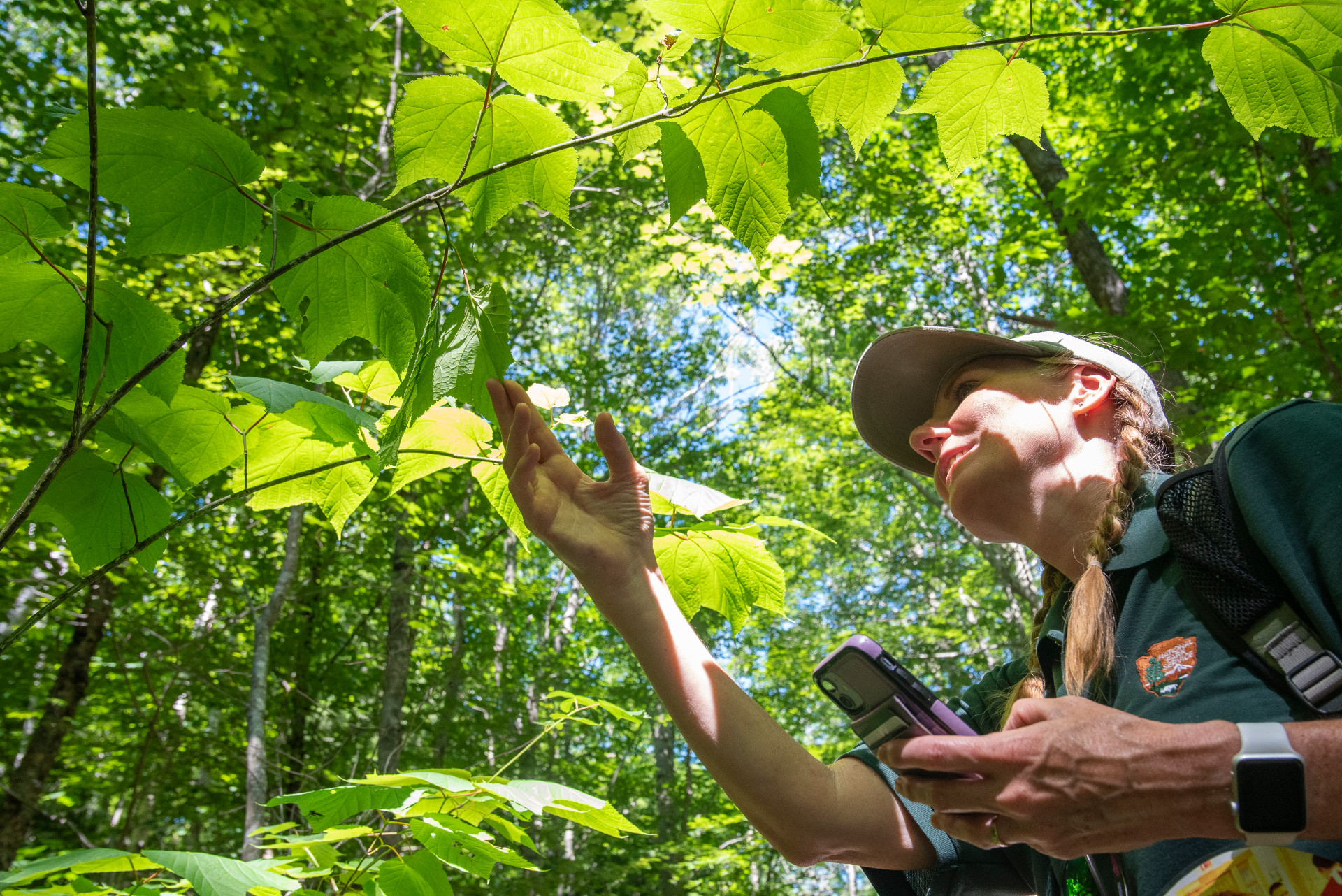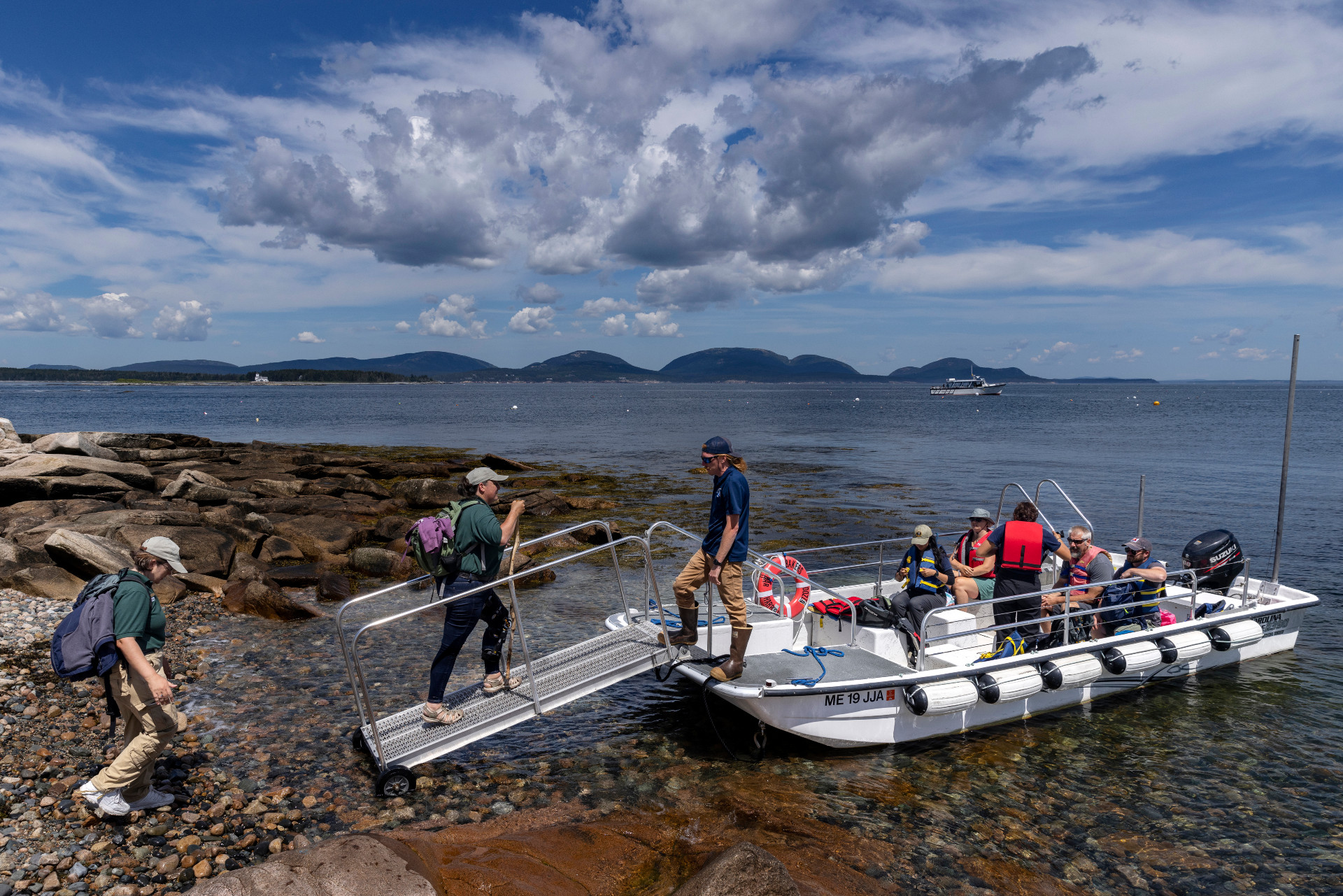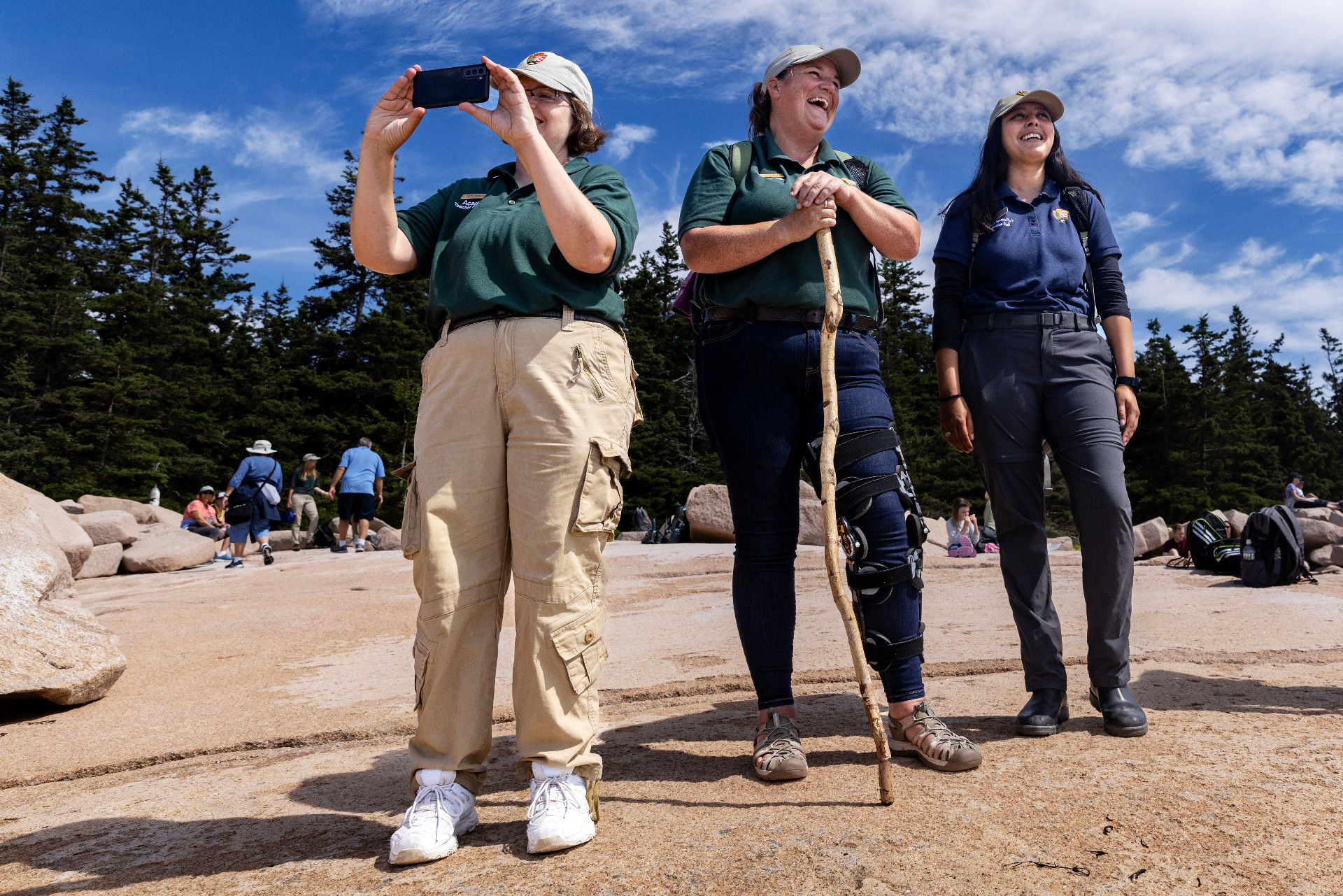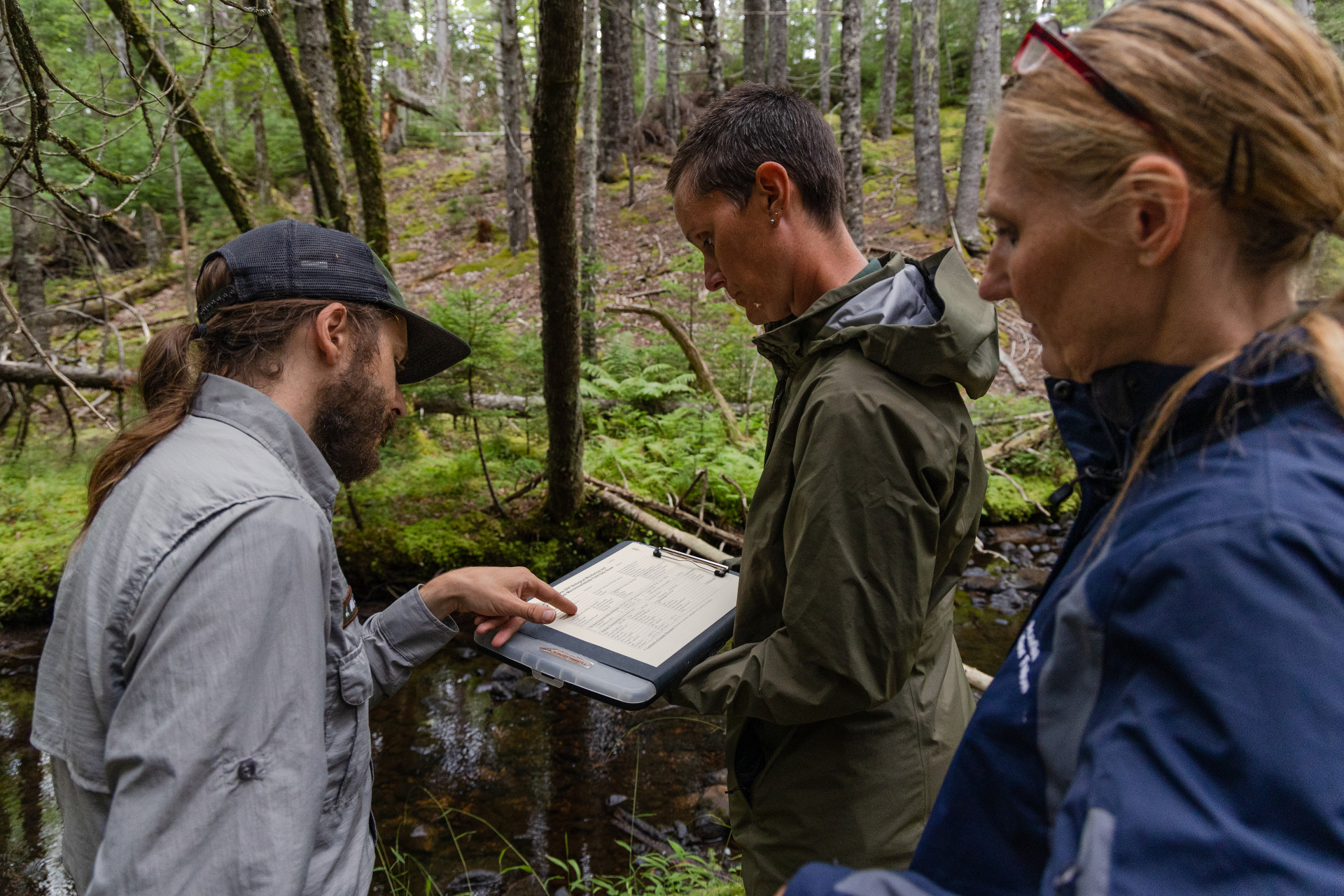Teachers are the Students in Acadia’s Outdoor Classroom
The Acadia Teacher Fellows program gives educators tools to cultivate outdoor classrooms.
October 18th, 2022
The Acadia Teacher Fellows program gives educators tools to cultivate outdoor classrooms.
October 18th, 2022

Acadia Teacher Fellow Kim Thornton observes an insect along Hemlock Path. (Photo by Avery Howe/Friends of Acadia)
BY SHANNON BRYAN
Students are more engaged when they’re learning outside.
When the classroom is comprised of open air and soil and things that grow, students are calmer and better able to focus. Research also shows that outdoor learning has positive effects on students’ mental health and academic performance, not to mention how exploring the outdoors helps students connect with their natural environments in memorable and energizing ways.
But creating an outdoor space — and a coinciding curriculum that fuels a student’s understanding and appreciation of nature — is a challenge for many teachers. Many schools lack green space on campus, particularly in our country’s inner cities where asphalt reigns.
Students who haven’t spent much time in nature might be nervous about what’s “out there,” and many teachers, no matter how enthusiastic about the idea, might not know where to start.
The Acadia Teacher Fellows program at Acadia National Park provides teachers with the tools to cultivate outdoor classrooms at their schools through an immersive six-week outdoor-learning experience.

Acadia Teacher Fellows Kate Studey and Blair Seney board a boat after spending the day exploring Baker Island and learning
about its history. (Photo by Ashley L. Conti/Friends of Acadia)
Funded by Friends of Acadia, the summer program invites a cohort of teachers from around the country to Acadia where they spend time exploring the park and training on outdoor learning initiatives. “During the program, they develop lesson plans and curriculum they want to implement in their home classrooms and schools, connecting their lessons to Acadia National Park,” said Paige Steele, Friends of Acadia’s Conservation Projects Manager.
“National parks are amazing outdoor classrooms, and school campuses can be, too!” said Steele. Learning in Acadia gives teachers the opportunity to experience an outdoor classroom themselves, connect with other teachers, and gain ideas they can implement back home, even if the landscape around their schools looks different.
“A big part of having an outdoor classroom is teaching students how to engage with the outdoors and helping them learn foundational skills,” Steele said. That might include how to dress for the weather, Leave No Trace principles, and the appropriate responses to outdoor stimuli – particularly for students who have not previously had much exposure to the outdoors. It might also include building up a cache of outdoor gear for students to use.
But for the teachers who participate, the experience extends far beyond fundamentals. It offers space to rejuvenate and explore alongside fellow educators, encouraging new ideas and a sense of community. That is one of the biggest take-aways for Blair Seney, a special education teacher from Houston, Texas, who was one of this summer’s Acadia Teacher Fellows.
“It was magic. It was like a summer camp for teachers,” Seney said. “I made lifelong friends this summer.”
The two months in Acadia include a wide range of learning experiences alongside knowledgeable park staff, giving the teacher fellows a behind-the-scenes look into park operations, education, trail maintenance, and more.
“We were able to see the other side of so many things,” said Leah Guenther, who teaches civics, social studies, and English to seventh and eighth graders at a K-8 school in the south side of Chicago. “Not just walking trails but working the trails. Not just looking at vegetation but cutting it back.”

Kate Studey (left) and Blair Seney (center) talk with Acadia National Park Teaching Assistant Courtney Martinez during a ranger-led tour in July. (Photo by Ashley L. Conti/Friends of Acadia)
Blair Seney grew up with a love for the outdoors thanks to her dad, who took her kayaking, camping, fishing, and hunting. When her father passed away two years ago, she sought the outdoors as a place to grieve and heal. Still, she said, “I didn’t understand the depth of change that can happen with students when you get them outdoors, the level of engagement.”
Many of Seney’s students don’t have the same opportunities to get outside that she did growing up. “I co-teach an aquatic science trip to Galveston to visit the ocean, where students catch their own fish,” she said.
“It’s the only field trip some of these students have ever been on.” Some schools in her district have already cut the program.
At many schools, outdoor space is lacking. “That’s the thing that holds teachers back the most—there’s no comfortable space,” Seney said. But now she’s determined to create that space for her students. “I think getting kids outdoors is vital. If we want them engaged, we need to get them outdoors.”
She plans on applying for an outdoor science classroom grant to help create an outdoor space at school where she and her co-teacher can lead lessons and where other teachers can take their classes, too. Seney said her time in Acadia as a Teacher Fellow revitalized her: “I got to find that wonder I had outdoors when I was a kid and feel that again.” She wants her students to feel that wonder, too.

Acadia National Park Physical Science Technician Jake Van Gorder (left), teaches Acadia Teacher Fellows Leah Guenther and Kim Thornton logging water quality data in Acadia National Park. (Photo by Sam Mallon/Friends of Acadia)
Leah Guenther feels comfortable outdoors, but she knows the students at her school in Chicago don’t have the same relationship—or access—to green space.
“There are some city parks where students play sports, and we have a basketball hoop in the school parking lot,” said Guenther. “But in general, being outside is not really a goal for a lot of kids. Our school is a mile from Lake Michigan, but students don’t spend time at the lakefront. It’s not something I hear them talking about.”
Guenther had tossed around the idea of re-imagining the school’s parking lot as an outdoor classroom, but the effort lost steam. “I had given up on that,” she said. “I thought, ‘Well, our school is what it is, our relationship to the outdoors is what it is, we’re in the city and we have the campus we have…”
“But because of the [Acadia Teacher Fellows] program’s emphasis on outdoor education and my experience, I ended up changing what I thought was possible,” she said. Now she’s recommitting to transforming the school grounds, and she’s found like-minded colleagues who want to help. “Since I’ve been back home, I have talked to several staff members interested in getting this going, something I didn’t realize was on other people’s minds.”
Guenther also plans to create lesson plans on public lands and national parks, trying to get the message to students that, as Americans, they own these parks and public lands, and it’s their right to be on them. She envisions an outdoor field trip at the end of the students’ eighth-grade year, as a culmination of the national parks’ lessons.
Maybe they’ll go to Indiana Dunes National Park, an hour away from school, for a night of camping or a service project and find a connection to the outdoors they didn’t have before. “My students don’t have that,” she said. “I want them to have that.”
Learn more about the Acadia Teacher Fellows program.
SHANNON BRYAN is Friends of Acadia’s Content and Website Manager.
Friends of Acadia works with Acadia National Park to support two different opportunities to help teachers facilitate outdoor learning in their classrooms: The Acadia Teacher Fellows program and the Outdoor Teacher Collaborative. Teachers can also apply for outdoor classroom grants.
Learn more